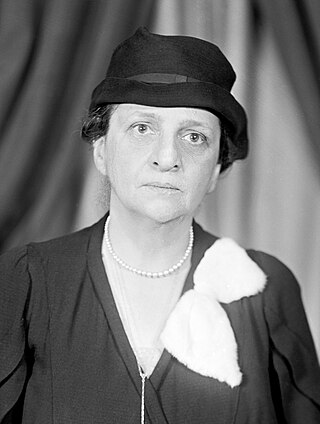
Frances Perkins was an American workers-rights advocate who served as the fourth United States Secretary of Labor from 1933 to 1945, the longest serving in that position. A member of the Democratic Party, Perkins was the first woman ever to serve in a presidential cabinet. As a loyal supporter of her longtime friend, President Franklin D. Roosevelt, she helped make labor issues important in the emerging New Deal coalition. She was one of two Roosevelt cabinet members to remain in office for his entire presidency.

The Charlotte Forten Grimké House is a historic house at 1608 R Street NW in the Dupont Circle neighborhood of Northwest Washington, D.C., United States. From 1881 to 1886, the house was home to Charlotte Forten Grimké (1837–1914), an African-American abolitionist and educator, one of the first Northerners to enter Union-controlled areas of the South during the American Civil War in order to teach freedmen and their children. The house was designated a National Historic Landmark in 1976.

The American Peace Society House, also known as the Glover House, is a historic house at 734 Jackson Place NW, facing Lafayette Square in the heart of Washington, D.C. Built in 1878 for banker and philanthropist Charles Carroll Glover, it is most notable as the national headquarters of the American Peace Society from 1911 to 1948. The Peace Society was one of the first overtly pacifist organizations in the nation, with a history dating to 1815. The house was declared a National Historic Landmark in 1974.
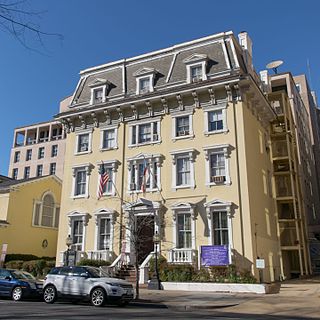
Ashburton House, also known as St. John's Church Parish House or the British Legation, is a historic house at 1525 H Street NW, on Lafayette Square in Washington, D.C. Built in 1836, it is notable as the residence of Lord Ashburton in 1842, during which time negotiations took place there culminating the Webster–Ashburton Treaty. This settled a long list of border disputes between the U.S. and the British provinces that are now Canada, and ended the Aroostook War. It was declared a National Historic Landmark in 1973. It presently serves as the parish house for St. John's Episcopal Church.

The Blanche K. Bruce House is a historic house at 909 M Street NW in Washington, D.C. Built in 1865, it was a home of slave-born Blanche K. Bruce, who was the first African-American to serve a full term in the U.S. Senate. It was declared a National Historic Landmark in 1975.

The General Oliver Otis Howard House, also known as Howard Hall, is a historic house, and the oldest surviving building on the campus of Howard University, in Washington, D.C. Built in 1867, it was the home of General Oliver Otis Howard, the university founder and its third president. The house was declared a National Historic Landmark in 1974. It faces Georgia Avenue NW, just north of Howard Place.

The Peter Parker House, also known as the former headquarters of the Carnegie Endowment for International Peace, is a historic row house at 700 Jackson Place NW in Washington D.C. Built in 1860, it is historically significant for its association with the Carnegie Endowment, whose headquarters it was from its founding in 1910 until 1948. The building was declared a National Historic Landmark in 1974. It has since been incorporated into the Blair House complex serving high-profile official visitors to the capital.
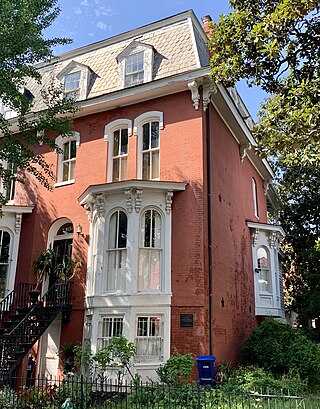
The Zalmon Richards House is a historic house in Washington, D.C. A Second Empire rowhouse, it was home from 1882 until his death of Zalmon Richards (1811–1899), founder of the National Education Association. It was declared a National Historic Landmark in 1965. It is a private residence.

Charles Evans Hughes House is a historic house at 2223 R Street, NW in the Sheridan-Kalorama neighborhood of Washington, D.C. Built in 1907, it was from 1930 to 1948 the home of Charles Evans Hughes (1862–1948), a prominent Republican politician and from 1930 to 1941 the Chief Justice of the United States. It was declared a National Historic Landmark in 1972 and is a contributing property to the Sheridan-Kalorama Historic District. It presently serves as the official residence of the Ambassador of Myanmar to the United States.
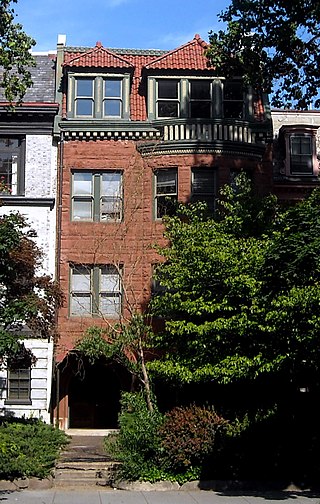
The Robert Simpson Woodward House is a former residence located at 1513 16th Street, NW in the Dupont Circle neighborhood of Washington, D.C. From 1904 until 1914, it was a home of geologist Robert Simpson Woodward (1849–1924), the first president of the Carnegie Institution and a highly regarded scientist and science administrator. The building currently serves as the Capital Research Center headquarters. It was declared a National Historic Landmark in 1976 and designated a contributing property to the Sixteenth Street Historic District in 1978.

The Oscar W. Underwood House is a historic house located in the Foggy Bottom neighborhood Northwest, Washington, D.C. It is nationally significant for its association with Major Archibald Butt, and painter Francis Davis Millet – both of whom died in the Titanic disaster on April 15, 1912 – and also Alabama politician Oscar Underwood (1862–1929) who lived there 1914–1925. It was the first long-term home of the Washington College of Law, the nation's first law school founded and run by women. The property was declared a National Historic Landmark in 1976. The building presently houses a legal aid clinic operated by George Washington University.

The American Red Cross National Headquarters is located at 430 17th Street NW in Washington, D.C. Built between 1915 and 1917, it serves both as a memorial to women who served in the American Civil War and as the headquarters building for the American Red Cross. It was declared a National Historic Landmark in 1965.

The United Mine Workers of America Building is an historic building at 900 Fifteenth St. NW in the Downtown neighborhood of Washington, D.C. Built in 1912 as the home of the University Club, a private social club, it was from 1936 to 1999 as the international headquarters of the United Mine Workers. Under the leadership of John L. Lewis, the union played a major role in improving working conditions and pay for a large number of mine workers, with Lewis eventually founding the Congress of Industrial Organizations to improve conditions for other types of laborers. The building was designated a National Historic Landmark in 2005. The upper floors of the building have been converted to residences.

The Mary Church Terrell House is a historic house at 326 T Street NW in Washington, D.C. It was a home of civil rights leader Mary Church Terrell (1863–1954), the first black woman to serve on an American school board, and a leading force in the desegregation of public accommodations in the nation's capital. Her home in the LeDroit Park section of Washington, DC was declared a National Historic Landmark in 1975. The building is a contributing property in the LeDroit Park Historic District.
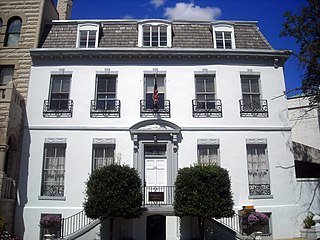
The Hiram W. Johnson House, also known as Mountjoy Bayly House, Chaplains Memorial Building or Parkington, is an historic house at 122 Maryland Avenue, Northeast, Washington, D.C., in the Capitol Hill neighborhood. Built about 1822, it is most notable as the home of Hiram Johnson (1866–1945), a prominent force in the Progressive Party of the early 20th century and its vice presidential candidate under Theodore Roosevelt in the 1912 election. It was declared a National Historic Landmark in 1976, and contributing property to the Capitol Hill Historic District.

The National Park System preserves and interprets the history of women in American society. Many national parks, monuments and historic sites represent America's women's history as a primary theme, while numerous others address American women's history somewhere in their programs and preservation activities. The lists of sites below is not exhaustive, but includes sites closely related to themes in U.S. Women's History. Click here for an article on Women in the National Park Service.

Roosevelt Hall (1903–1907) is an immense Beaux Arts-style building housing the National War College on Fort Lesley J. McNair, Washington, DC, USA. The original home of the Army War College (1907–1946), it is now designated a National Historical Landmark (1972) and listed on the National Register of Historic Places (1972).

The Main Interior Building, officially known as the Stewart Lee Udall Department of the Interior Building, located in Washington, D.C., is the headquarters of the United States Department of the Interior.

The Andrew W. Mellon Auditorium is a 750-seat historic Neoclassical auditorium located at 1301 Constitution Avenue NW in Washington, D.C. The auditorium, which connects two wings of the William Jefferson Clinton Federal Building, is owned by the U.S. government but available for use by the public.

The Perkins Homestead, also known as the Brick House, is a historic homestead at 478 River Road in Newcastle, Maine. The 57-acre (23 ha) property, including its 1837 brick farmhouse, was designated a National Historic Landmark for its association with the life of Frances Perkins (1880–1965), the first woman to hold a position in the United States Cabinet. Perkins spent many years, both as a child and later as an adult, at this property, which she considered to be her true home. The property was first listed on the National Register of Historic Places in 2009 as the Brick House Historic District in part for its archaeological significance.





















